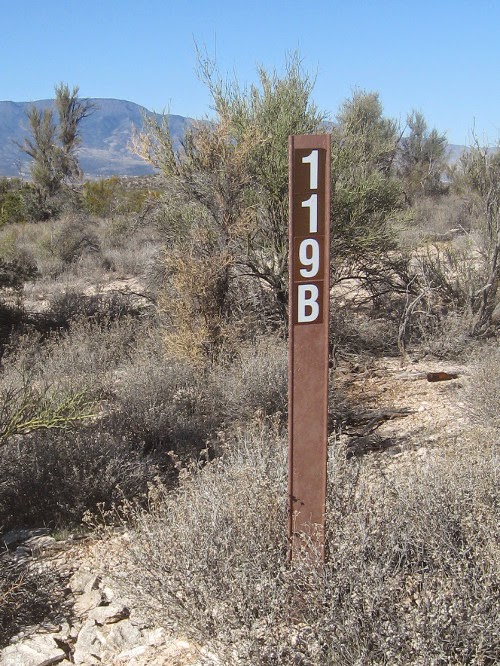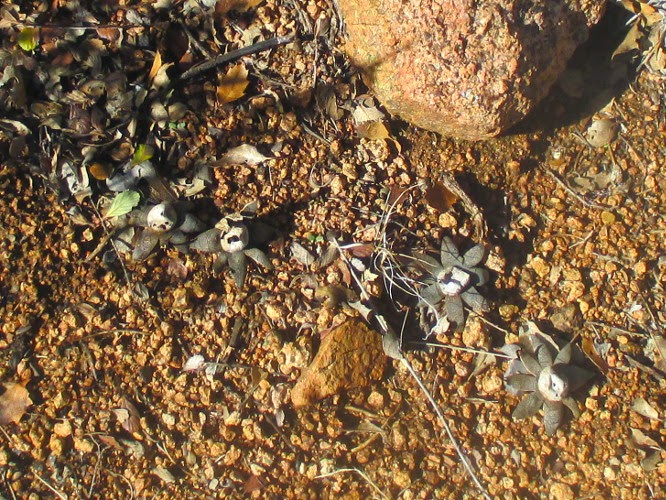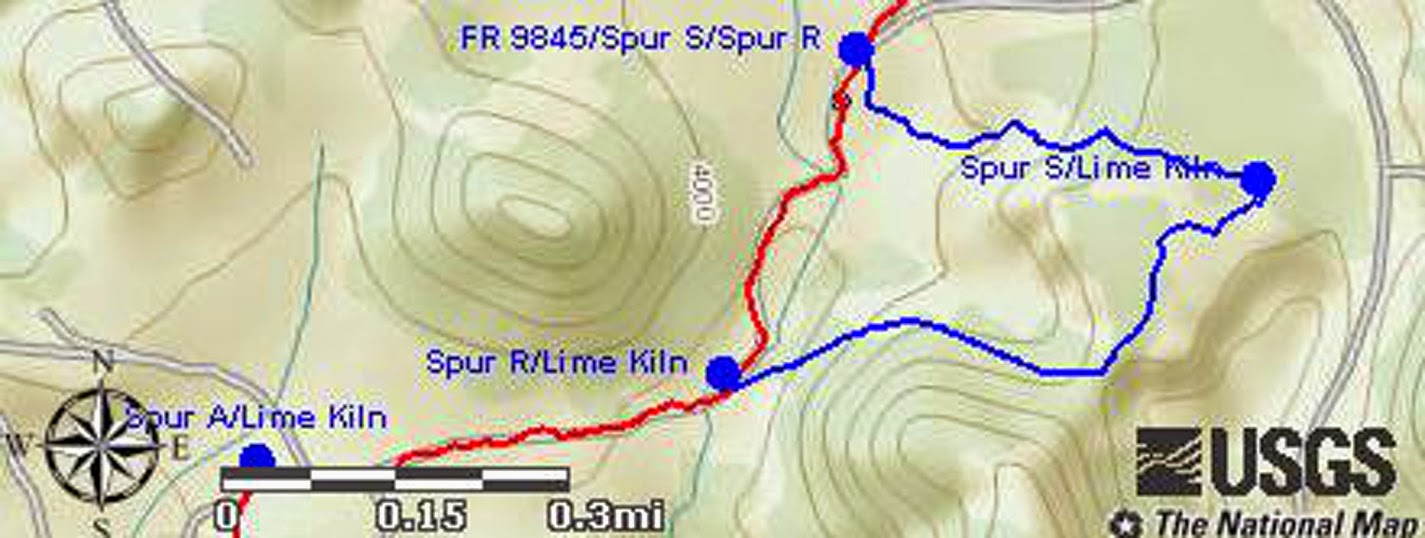On
22 November 2014 the author and one other hiker who chose to remain
unidentified left Cottonwood at 0700 to hike Little Wolf Creek Trail.
Donna Goodman who lives near Prescott met us in the town of Mayer
and we proceeded to the trailhead.
 From
Cottonwood, we drove east on Hwy 260, turned south on Interstate 17
and continued to Hwy 69 (Exit 262). We then drove north on Hwy 69
for 8.1 miles to Mayer, turned left onto E Central Avenue and stopped
to pick up Donna. The three of us continued for 0.3 miles on E
Central, turned left onto Miami Street and then almost immediately
right onto Wicks Avenue. We continued on Wicks for 0.2 miles and
turned left onto Jefferson Street. Jefferson Street soon turns into
a dirt road and then becomes either Forest Road 67 or County
Road 177.
It is posted as County 177, but some maps I have seen label it as
Forest Road 67. In any case, after first turning onto Jefferson
Street, we just followed the road for 6.9 miles and parked at a
hairpin turn in the road. Despite the number shown, the sign (right)
does mark the lower trailhead for Little Wolf Creek Trail #304.
From
Cottonwood, we drove east on Hwy 260, turned south on Interstate 17
and continued to Hwy 69 (Exit 262). We then drove north on Hwy 69
for 8.1 miles to Mayer, turned left onto E Central Avenue and stopped
to pick up Donna. The three of us continued for 0.3 miles on E
Central, turned left onto Miami Street and then almost immediately
right onto Wicks Avenue. We continued on Wicks for 0.2 miles and
turned left onto Jefferson Street. Jefferson Street soon turns into
a dirt road and then becomes either Forest Road 67 or County
Road 177.
It is posted as County 177, but some maps I have seen label it as
Forest Road 67. In any case, after first turning onto Jefferson
Street, we just followed the road for 6.9 miles and parked at a
hairpin turn in the road. Despite the number shown, the sign (right)
does mark the lower trailhead for Little Wolf Creek Trail #304.
I
think the posted trail number, #9434, is because part of the trail
has a double designation as a hiking trail and for ATV use. But
after about 1.2 miles, a point marked by a corral, the trail is no
longer suitable for other than hikers, horseback riders and mountain
bikers.
Leaving
the trailhead we at first hiked along a streambed on the remains of
an old road. Parts of the old road had washed out and it was very
rocky in a few spots, especially when crossing the dry streambed,
which we did at least twice. About 0.6 miles from the trailhead,
just north of the Pipeline Canyon junction, the trail turned away
from the bottom of Little Wolf Creek Canyon and we climbed along the
shoulder of a high ridge that separates Pipeline Canyon from Little
Wolf Creek Canyon. From here the trail then quickly descended to
cross the Taft Canyon Wash and climbed another ridge on the other
side between Taft Canyon and Little Wolf Creek Canyon. From the top
of this ridge, we had a good view of the area ahead that we would be
hiking through, including the scars of old mines on the mountain
slope below Big Bug Mesa.
In
the photograph below Big Bug Mesa is shown on the left, Little Mesa
is on the right and between them is Coyote Spring Saddle. The two
scars, one below the saddle and one to the left of it, show the
locations of the old mines. Although not visible here, a third
abandoned mine exists at the foot of the mountain alongside Little
Wolf Creek.
 |
Showing Big Bug Mesa, Little Mesa and the saddle between them
|
From
our position high up on the ridge, we could also look back down
Little Wolf Creek Canyon and on to the far mountains. In the center
of the photograph below, the prominent formation looming just at the
mouth of the canyon is Brady Butte.
 |
Looking out the mouth of Little Wolf Creek Canyon from a ridge of Big Bug Mesa
|
 The
ridge we were on was covered with scrub oak, junipers, mountain
mahogany and other assorted low-growing plants. The mountain
mahogany (left), having not yet
released its feathery, winged seed pods was absolutely glowing in the
morning sun.
The
ridge we were on was covered with scrub oak, junipers, mountain
mahogany and other assorted low-growing plants. The mountain
mahogany (left), having not yet
released its feathery, winged seed pods was absolutely glowing in the
morning sun.
The
trail now descended back into Little Wolf Creek Canyon after which it
would follow closely along the streambed for the rest of the way to
the saddle at Coyote Spring.
Just
as we approached the creek we came to the corral beyond which, the
use of motorized vehicles, if not prohibited, is at least quite
impractical. I say “if not prohibited” because I never did see a
sign that actually said they were not allowed.
 There
were still vestiges of an old road as we continued along the trail
above the corral, and a little later we found an abandoned mine,
probably explaining the old road, located just across the creek from
the trail. We did not visit the mine on this trip, but I did visit
it last April and took a photograph (right)
of the shaft opening. The opening appeared too small for this to
have been a major operation. On the other hand there was a large
tailings deposit alongside the creek, so it may have been a larger
operation than the opening would seem to indicate.
There
were still vestiges of an old road as we continued along the trail
above the corral, and a little later we found an abandoned mine,
probably explaining the old road, located just across the creek from
the trail. We did not visit the mine on this trip, but I did visit
it last April and took a photograph (right)
of the shaft opening. The opening appeared too small for this to
have been a major operation. On the other hand there was a large
tailings deposit alongside the creek, so it may have been a larger
operation than the opening would seem to indicate.
A
little farther up the trail was the remains of what must once have
been a cozy dugout-cum-cabin (left).
It was rather small, perhaps 80 square feet, but showed the remains
of what would have been a quite impressive fireplace. Could this
have been where the mine operator lived?
We
were now traveling through a ponderosa forest that would continue
until we reached the saddle at Coyote Springs. We saw some faint
signs of recent usage of the trail by mountain bikers but nothing
else to suggest that anyone else had passed this way for awhile.
Despite this it was easy to follow. I thought that I remembered
seeing evidence of usage by cattle last April. However, we now found
no such signs.
Although
it had been a little chilly earlier in the morning when we were lower
in the canyon and the surrounding mountains had blocked the morning
sun, it was now quite comfortable.
When
we arrived at the saddle we looked around a bit for evidence of
Coyote Spring, but saw no sign of water anywhere. The drainage from
this point is to the north to Grapevine Creek, about a mile ahead,
and I suppose the spring might be somewhere down that drainage. Or
perhaps it dried up after the place was named.
 |
The saddle at Coyote Springs
|
 The
saddle is the only place that it would seem possible to lose the
trail. We had hesitated here when scouting the trail, but then
decided that it turned left rather than crossing the fence. Once one
makes the turn the trail becomes quite obvious again. Unfortunately
for those averse to climbing it now attacks Big Bug Mesa head on,
rising around 560 feet in 0.5 miles and crossing some rocky terrain.
The photograph (right) was taken
looking back down the trail. There are few switchbacks to break the
climb.
The
saddle is the only place that it would seem possible to lose the
trail. We had hesitated here when scouting the trail, but then
decided that it turned left rather than crossing the fence. Once one
makes the turn the trail becomes quite obvious again. Unfortunately
for those averse to climbing it now attacks Big Bug Mesa head on,
rising around 560 feet in 0.5 miles and crossing some rocky terrain.
The photograph (right) was taken
looking back down the trail. There are few switchbacks to break the
climb.
I
decided that some early day cowboy must have laid out the trail by
leading his least favorite cow to the edge of Big Bug Mesa and
pushing her over the rim. He then just followed the path she took
to the bottom, the only switchbacks being where she bounced off a
tree and fell sideways .
We
broke the hike by stopping several times to rest and enjoy the
scenery. Looking to the northeast through the saddle we had just
left we could see automobile and truck traffic along Hwy 69 between
Mayer and Dewey-Humboldt, probably around Poland Junction.
 |
Looking down on the valley above Mayer from the trail ascending Big Bug Mesa
|
 We
left the ponderosas that were growing lower down the slope and were
once again in an area populated by smaller plants. Mountain mahogany
was again plentiful and even smaller plants such as the occasional
Indian paintbrush and the colorful buckwheat shown in the photograph
(left) were growing in open spaces
along the trail.
We
left the ponderosas that were growing lower down the slope and were
once again in an area populated by smaller plants. Mountain mahogany
was again plentiful and even smaller plants such as the occasional
Indian paintbrush and the colorful buckwheat shown in the photograph
(left) were growing in open spaces
along the trail.
When
we reached the rim of the mesa, we were still 0.3 miles from the
upper trailhead at Forest Road 9434. But the terrain was now
essentially flat, rising only another 150 feet to the trailhead, a
welcome change from the steep climb to the rim.
From
the trailhead one has a good view across Big Bug Mesa to the Bradshaw
Mountains beyond. The trailhead is marked by a rock cairn,
essentially just a rather substantial pile of rocks alongside the
road.
 |
Bradshaw Mountains in the distance, cairn in bottom right quadrant
|
 The
inset map (right) shows our climb
from Coyote Springs Pass to the end of Trail 304 on Big Bug Mesa.
This was the most difficult part of the hike and several of the
hikers who made the scouting hike last April took one look and chose
to wait at the saddle.
The
inset map (right) shows our climb
from Coyote Springs Pass to the end of Trail 304 on Big Bug Mesa.
This was the most difficult part of the hike and several of the
hikers who made the scouting hike last April took one look and chose
to wait at the saddle.
Today,
however, all three hikers made it all the way to the end of the
trail, arriving just at lunch time. That meant that we could eat our
main meal exactly half way through the hike, always a good plan. But
we decided to make a slight modification due to a breeze that had
arisen and hike back to the rim where we would be sheltered by the
trees from the rather chilly wind.
Before
we left the trailhead, Donna and I posed in front of the trailhead
sign mounted under the juniper growing alongside the cairn that
marked the trailhead. So, yes, the upper trailhead is marked as
Trail 304 while the lower trailhead is marked as Trail 9434.
 |
Left to right: Donna Goodman and the author – photograph by Name Withheld
|
The
hard part of our hike was done, so we felt entitled to a leisurely
lunch which we ate looking out over the valley below.
This
round trip distance for this in and out hike was
7.9 miles, the highest elevation was 6876 feet and the total ascent
was 1925 feet.
Our
GPS track is shown in red on the included map (next
page) and various
points of interest are labeled. Note that both Pipeline Canyon and
Taft Canyon feed in from the northwest. Also note that Taft Canyon
runs parallel to Little Wolf Creek Canyon for a considerable distance
before actually feeding into it.
 About
0.3 miles along from the place where the hikers stopped for a snack,
they came to the junction of FR 119A with FR 119B (right).
FR 119A turns to the northeast and continues on to connect with
Cornville Road at the Cornville Road/Beaverhead Flat Road junction.
According to Leon Girdner who grew up in this area, what is now FR
119A was once part of the main road between Camp Verde and Cornville.
About
0.3 miles along from the place where the hikers stopped for a snack,
they came to the junction of FR 119A with FR 119B (right).
FR 119A turns to the northeast and continues on to connect with
Cornville Road at the Cornville Road/Beaverhead Flat Road junction.
According to Leon Girdner who grew up in this area, what is now FR
119A was once part of the main road between Camp Verde and Cornville. About
1.2 miles after turning onto FR 119B, the hikers crawled under a
fence (left), luckily one with a
smooth bottom strand, and bushwhacked up to the summit of a small
hill to eat lunch with a view. Hikers are shown at lower left, the
summit is at upper right.
About
1.2 miles after turning onto FR 119B, the hikers crawled under a
fence (left), luckily one with a
smooth bottom strand, and bushwhacked up to the summit of a small
hill to eat lunch with a view. Hikers are shown at lower left, the
summit is at upper right.


 On
the return hike, several members of the party forsook the road part
way down Granada Wash in favor of traveling down the streambed
(right). Lila reported that the
bottom of the wash was sandy and that the walking was easy with only
a few small rock ledges that were easily descended.
On
the return hike, several members of the party forsook the road part
way down Granada Wash in favor of traveling down the streambed
(right). Lila reported that the
bottom of the wash was sandy and that the walking was easy with only
a few small rock ledges that were easily descended.






















































